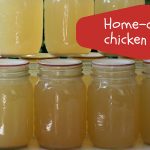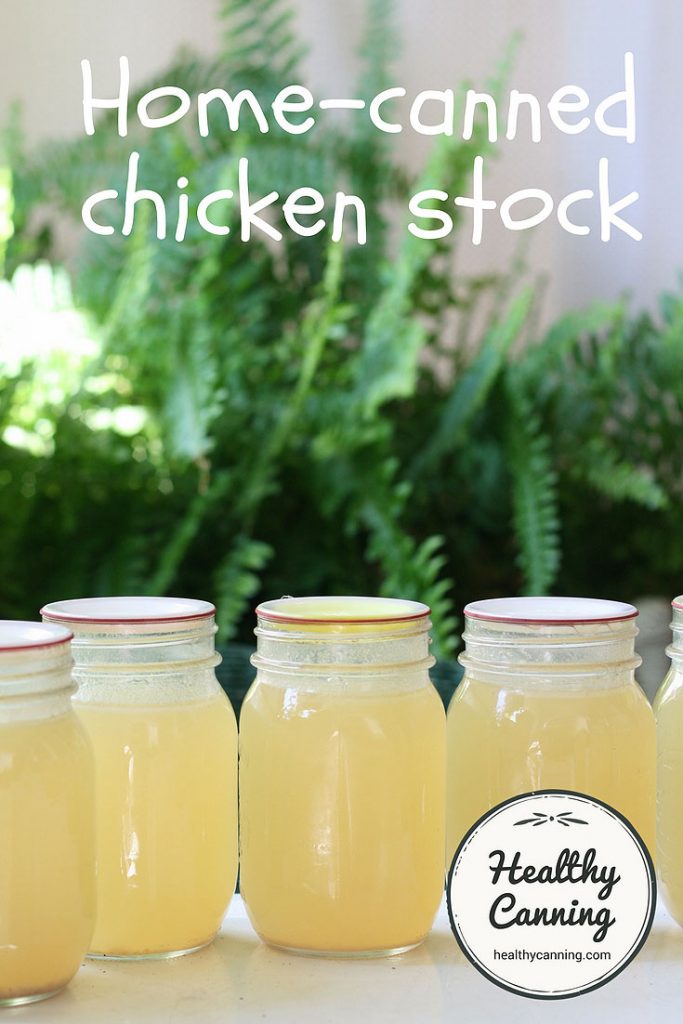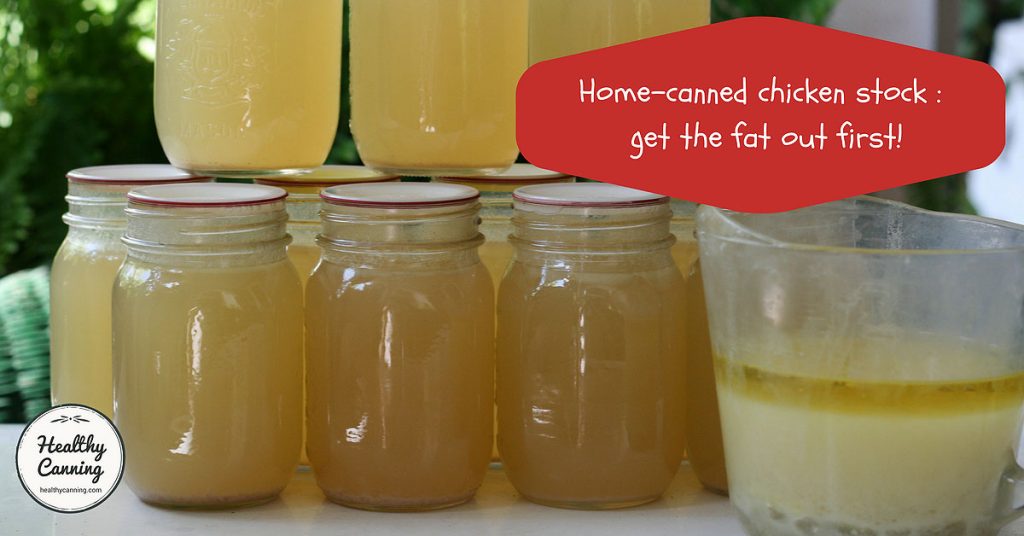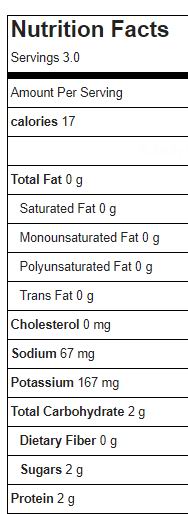Home canned chicken stock, without all the sodium dumped into commercial versions meant to make up for lack of actual flavour!
Here we walk through the USDA procedure for making chicken stock.
See also: Canning turkey stock.
The recipe
Jar size choices: Either half-litre (1 US pint) OR 1 litre (1 US quart)
Processing method: pressure canning only
Yield: varies
Headspace: 3 cm (1 inch)
Processing pressure: 10 lbs (69 kPa) weighted gauge, 11 lbs (76 kpa) dial gauge (adjust pressure for your altitude when over 300 metres / 1000 feet.)
Processing time: Half-litres (pints) 20 minutes; litres (quarts) 25 minutes.

Canning chicken stock
Ingredients
- chicken bones (or carcass)
- water
Instructions
- Take chicken bones or carcass, clean all meat off it. (Tip: you can freeze meat in a baggie for adding to soup later.)
- (Optional: Some people like to roast the bones for an hour or so at this point, for a darker, richer-tasting stock. )
- EITHER : Put bones / carcass in pot with enough water to cover. Bring to a boil, cover, and simmer for 45 minutes. OR Put in pressure cooker. Add enough water to cover bones. Cook for 30 minutes on high pressure (13 to 15 lbs for most North Americans. See Notes.) A couple bay leaves tossed into either process make an inspired addition.
- Strain into a large bowl or tub; have a second go at picking more of the loosened meat off it, add that to your bag of frozen meat, and put the stock in fridge over night.
- In the morning, scrape all the fat off the top; discard the fat.
- Reheat the stock to boiling in microwave (or pot.) If you used a microwave, be careful of surge when removing.
- Pour hot into half-litre (1 US pint) jars or 1 litre (US quart) jars.
- Leave 3 cm (1 inch) headspace.
- Wipe rims.
- Put lids on, put in pressure canner.
- Processing pressure: 10 lbs (69 kPa) weighted gauge, 11 lbs (76 kpa) dial gauge (adjust pressure for your altitude when over 300 metres / 1000 feet.)
- Processing time: half-litre (1 US pint) jars for 20 minutes. OR 1 litre (1 US quart) jars for 25 minutes.
Nutrition
See also if applicable: Dial Gauge Pressures.
Reference information
How to pressure can.
When pressure canning, you must adjust the pressure for your altitude.
What is the shelf life of home canned goods?
Chicken stock flavouring options
The USDA and So Easy to Preserve give directions for plain, pure chicken stock, unfiltered.
Ball and Bernardin add flavouring options. The Bernardin Guide (2013, page 99) and the Ball / Bernardin Complete (2015, page 399) suggest you add 2 stalks celery, 2 onions cut into quarters, and 10 peppercorns. The Ball Blue Book (37th edition, 2014, page 105) suggest those items plus 2 carrots. All 3 of those books have you remove and discard those items along with the bones before canning the broth. They also add the suggestion that you strain the broth through a cheesecloth-lined sieve before canning to remove any particles from it. Their canning and processing times are identical otherwise.
Notes
- Note: you may see some people saying they simmer, boil or pressure cook chicken bones for stock for 5 or 6 hours. Should you choose to boil, notice that the USDA suggests that 45 minutes is completely adequate. And if pressure cooking, 30 minutes will yield the maximum result you are going to get. Any time beyond that is really just increasing your cooking fuel bill with zero benefit to show for it.
- Laura Pazzaglia, author of Hip Pressure Cooking, says that for pressure cooking (note, not pressure canning), HIGH PRESSURE equals 13 to 15 lbs, or 90 to 100 kilopascals, or .9 to 1 bar. [1]Pazzaglia, Laura. Hip Pressure Cooking. New York: St Martin’s Griffin. 2014. Page 12. The pressure cooking time of 30 minutes for poultry stock also comes from the same excellent book, page 48. Note: if you are using an electric pressure cooker to make the stock in, such as an Instant Pot, she advises increasing the time to 33 to 35 minutes. (Don’t take our word: check with her over at hippressurecooking.com.)
- Above all, please do keep clear the difference between pressure cooking the stock to save energy and produce a superior stock, and then pressure canning it later to preserve it.
- Roasting the chicken bones can result in a wonderful deep rich flavour but also results in a quite dark stock, usually (photos show on this page show stock from unroasted bones.)
- Safety tip: After you have a plate of meat you have picked off a chicken carcass, always take a minute to feel carefully through that meat with your fingers, pressing it all, feeling for small bones.
- Pressure cooking uses less energy and extracts more flavour and gelatin from the bones, resulting in a better quality stock to can.
- A bay leaf or two while you are boiling or pressure cooking the bones will elevate your stock.
- You could add a bit of salt or salt sub per jar, but it could be argued that it’s just better to can it as is, then do flavour adjustments when you go to use it in something.
- When discarding the fat, check how to best do so for your area. Many municipalities are now saying they do not want it going down your drain and into their sewer systems, where it causes great problems overtime.
- The USDA Complete and So Easy to Preserve do allow that you can add tidbits of chicken meat to the stock. As there is no definition of what quantity of meat that exactly allows, and we’d never be able to answer that question for ourselves let alone others, we have left that out of the directions. But that certainly is there as part of it. Ball and Bernardin don’t have that: as noted above, they have you strain the stock to get anything out.
Recipe Source
United States Department of Agriculture (USDA). Complete guide to home canning. Agriculture information bulletin No. 539. 2015. Page 5 – 7.
Modifications
- Added bay leaf for flavour;
- Added phase of overnight in fridge to skim fat off.
Nutrition
Serving size: 250 ml ( 1 cup / 8 oz )
Per 250 ml ( 1 cup / 8 oz ): 17 calories
Weight Watchers PointsPlus®: 250 ml (1 cup / 8 oz ): 0 points; 500 ml ( 1 US pint / 2 cups/ 16 oz): 1 point.
Weight Watchers SmartPoints®: 250 ml (1 cup / 8 oz ): 1 point; 500 ml ( 1 US pint / 2 cups/ 16 oz): 1 point.
* Nutrition info provided by MyFitnessPal.
* PointsPlus™ and SmartPoints™ calculated by healthycanning.com. Not endorsed by Weight Watchers® International, Inc, which is the owner of the PointsPlus® and SmartPoints® registered trademarks.
References





Elaine
When making chicken stock I have read to peel carrots first but is it necessary to peel onions as it will all be strained before canning ? Thank you
Joey
Can I put hole chiken legs in my broth to cook them and strain everything after?
Healthy Canning
Yes.
Stine
Do you foresee any issues using bones from smoked carcass? I’ve smoked duck and made stock for the freezer from it in the past, but I’d love to have it shelf stable.
Healthy Canning
It’s difficult to imagine that there would be any issue, as it’s just the stock that is getting canned, not the smoked meat or bones.
delores
I put stock in hot in Jars put on lid and after a few minutes the Pop it was sealed so why do I have to pressure cook the jars?
Healthy Canning
The seal is doing nothing for you in terms of achieving safety. You need to sterilize the contents of the jars through pressure canning. The seal only helps to safeguard that safety that you achieved during the pressure canning process. You should be freezing your chicken stock if you do not have a pressure canner. The very real risk is botulism.
Sue Parker
I am new to this page and already love it. I’ve been canning chicken breasts (40 lbs) and plan to start on chicken thighs and legs so this is the perfect website for all my questions on canning broth. Thanks again for your help and suggestions.
Dave
I am trying to reference/verify information about cook time for boiling bones. Where did you find that the USDA says how long to boil bones for or where tests have been done for maximum results?
“Note: you may see some people saying they simmer, boil or pressure cook chicken bones for stock for 5 or 6 hours. Should you choose to boil, notice that the USDA suggests that 45 minutes is completely adequate. And if pressure cooking, 30 minutes will yield the maximum result you are going to get. Any time beyond that is really just increasing your cooking fuel bill with zero benefit to show for it.”
Thanks,
Dave
Healthy Canning
Laura Pazzaglia, Hip Pressure Cooking.
RICHARD MCCLELLAND
Do I need to remove the fat to pressure can it?
Healthy Canning
If you make a good effort to skim off excess fat, you will thank yourself. You will experience far fewer sealing failures, and for the jars of chicken stock that end up lasting on the shelves 2 or 3 years (yes, it will happen) the chance of any rancidity from the fat will be greatly diminished.
Vesna Kovach
I don’t skim the fat. I do get more canning failures than with other foods. (Perhaps 1 jar out of ten won’t seal.) I consider this an acceptable cost. Chicken fat (schmaltz) has velvety texture and rich flavor. The odd unsealed jar goes in the refrigerator to be used within a week or two.
Sarah
How much fat can I get away with leaving in the chicken stock when I pressure can it? I like to make a large batch and chilling it is very difficult in the summer – and I’m almost out. I usually make stocks in the winter when it is VERY cold outside at night – and chill it overnight there. Yes.
Healthy Canning
You can drag a piece of paper towel over the top of stock to soak up grease floating on top.
Debbie Ritter
Can I process chicken stock and bone broth in a traditional hot water bath rather than a pressure cooker?
Healthy Canning
Absolutely not :} In the absence of a proper, real pressure canner, freeze them. Tip to save freezer space: make the broths really concentrated. A pressure cooker can be ideal for doing this. If you got a pressure canner such as the inexpensive Presto 16 quart one which is a dual pressure cooker / canner, you could first use it as a pressure cooker to make the best ever bone broth, and then you could use it as a pressure canner, to can it.) Here’s some really helpful advice on stock: https://www.hippressurecooking.com/pressure-cooked-chicken-broth-lesson-6-making-chicken-stock-in-the-pressure-cooker/
Amanda
I have a question about flavoring stocks – I like to simmer my chicken bones with carrot, celery and onion and add a shot of apple cider vinegar as well. Since I would strain the solids out and they are merely flavoring agents, the stock would still be safe to pressure can, correct?
Healthy Canning
Correct Amanda. Yes you can do that. I’ll add a note about that.